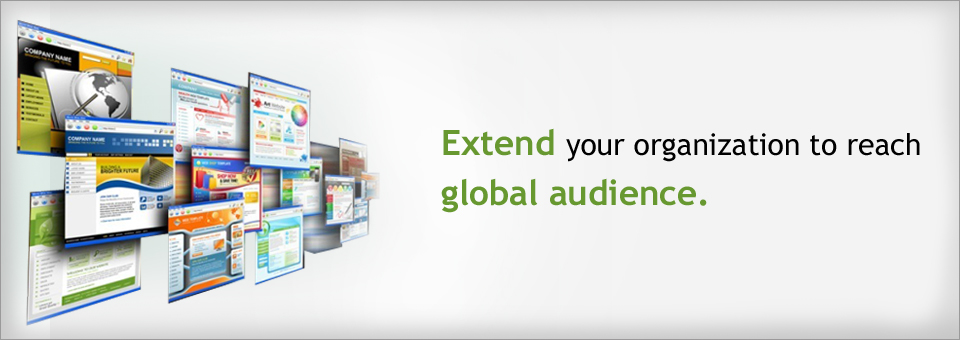WEB DEVELOPMENT
What is a web application?
A web application is an application that is accessed via web browser over the Internet or an intranet. In that sense a web application is like a website. But a web application is much more powerful as it is dynamic, typically allows users to login, view and manage content, etc. Examples of web applications include online banking systems, Google mail, Customer web portals, Google docs, etc.
Frameworks & Technology used
We are passionate about web technologies and constantly keep an eye out for new technologies that make us more efficient. We favour .Net and open source technologies LAMP. We extensively use Zend Framework, ExtJS, jQuery and AJAX. With high load projects we successfully increase throughput with the Cloud computing, Node.js and HTML5. We are a technology centric company so we are happy to customize and integrate projects.
Web 2.0 based development
Social networking has changed the way user interacts on the web. A Web 2.0 site allows users to interact and collaborate with each other. In essence a Web 2.0 site becomes a platform with more sophisticated user experience. We Achieve Web 2.0 functionality in the website by ensuring the following:
- Usable and rich interface with technologies like AJAX, etc
- Let other systems integrate by providing features like RSS Feeds and Web Services
- Build tools to let users share thoughts and experiences
- Usable and rich interface with technologies like AJAX, etc
- Let other systems integrate by providing features like RSS Feeds and Web Services
- Build tools to let users share thoughts and experiences
HTML5 Web Development
HTML is the language that all the websites use.HTML5 is the next major upgrade of the HTML standard. HTML5 has taken the web user experience to the next level with its amazing effects and Rich media capabilities, and our team take pride to have developed fairly large applications and websites using HTML5 technology.
HTML5 is not supported by all old browsers and all modern browsers are constantly improving to support these new HTML5 standards. Our expertise help clients to port their existing web applications to HTML5 with enhancing engagement experience for users that have newer browsers while retaining old functionality for older browsers.
Other existing Html5 pilot projects are on following areas
- Flash to HTML5 conversion
- M-learning
- Timed media playback
- Offline Web Applications
- Document editing
- Cross-document messaging
- Browser history management
- MIME type and protocol handler registration
- Microdata
- Web Storage
- Geolocation
- Web SQL Database
- The Indexed Database API
- HTML5 File API ,Directories and System
- File Writer
- Web Audio API
- HTML5 video
- Push technology to send updates from the server (Web sockets)
Progressive enhancement
With web development an unique challenge is lack of control over the tools visitors use to view a website. There are users with older browsers and people on newer mobile devices without support for advanced Javascript or Flash plugins. Even internet connection speeds can be a major issue on content rich websites. The core aim with Progressive enhancement is to guarantee that all the users have access to content irrespective of what device they use. Some advantages are:
- Improved SEO by ensuring that search engines get all content
- Support for browsers on mobile devices, desktops and screens with larger resolutions
Load Testing
Load testing is the process of putting demand on a server and measuring its response. Load testing is performed to determine a web applications stability under both normal and anticipated peak load conditions. It helps to identify the maximum operating capacity of an application as well as any bottlenecks and determine which element is causing delays on page load times. The aim with load testing is to prevent slow load times and site crashes.
High Performance scaling
Scalability of a web application indicates its ability to handle growing amounts of users in a graceful manner. Designing for scale is a challenge when building web applications. To be able to handle a high number of users, several factors have to be considered. A solution that worked for a web application need not apply to every system as each requirement and process is different. However, if a web application is designed with the intention to scale in the future in mind, it can be scaled in stages. At a minimum all our web applications using our development Framework are designed to run on a separate database server or a cluster if required. Recently, we have been using cloud based CDN's to offload server load for static content and offline processing with on demand servers.
Security Audits
We have independently reviewed critical web applications to ensure compliance with internal security guidelines. We understand that security is a measure and not a property. In other words, the question, "How secure is my web application?" makes more sense compared to "Is my web application secure?". After having carried out initial security checks to ensure that the code and system is satisfactorily protected, the next step is to ensure that the system is constantly monitored to keep attackers at bay and ensure smooth running of the web application.
Contact us for more information













